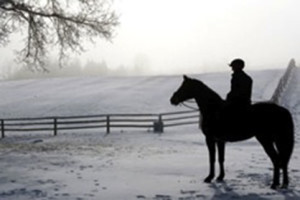Wintertime Tips For Equestrians
 Michigan State University Extension
Michigan State University Extension
By: Taylor Fabus
Keep these tips in mind as our seasons change and old-man winter makes his mark!
Watering in winter
That’s right, although the temperatures have dropped, it is just as important in winter to provide your horse with lots of clean drinking water. During the warmer months, horses and other grazing livestock receive much of their hydration from grass. When weather prevents grazing, recognize that horses will often consume more of their daily water intake from troughs and buckets.
Unless you are privileged with a heated barn, you are likely to put on some muscle mass chipping the ice out of your horse’s water buckets. Think about instead installing water heaters to eliminate this hassle. Visit your local hardware store to see the options that they have for heated water buckets, troughs and even heated hoses.
To blanket or not to blanket?
There are several things to take into consideration when deciding whether or not to blanket your horse this winter, not the least of which is considering your horse’s job and activity level. Are you planning to show all winter long? If you are hitting the highways this winter with your horse, you are likely concerned about maintaining a summer-like hair coat. If this is the case, then you are a perfect candidate for a blanketing regimen or even a heated barn. However, do not forget about ventilation in your barn. A barn that is lacking in ventilation (like those completely closed up or heated for winter), can create a buildup of ammonia from the soiled stalls. Research shows that ammonia buildup that reaches levels high enough for us to smell can be strong enough to permanently damage horses’ lungs.
If you’re not too concerned with keeping your horse’s show coat all year-round, could consider lightweight, waterproof blankets on wet days. Sending your horse out into the elements with a touch of protection can keep them dry, while still allowing them to grow a nice thick coat to keep them warm. One thing to keep in mind is making sure your blanket stays dry. Think about having two blankets that you can rotate, or at least remove the wet blanket until it is dry. Remember, a dry horse is a happy horse! Check out your nearest tack store to browse their selection of waterproof horse wear. Also, check out Michigan State University Extension’s article Blanketing horses requires additional management for more information.
Facts about blanket fit
Be sure to also check the fit of your horse’s blanket or sheet. A blanket that is too small can create areas of irritation on your horse’s body. Small blankets can even rub bare spots on your horse’s coat. On the other hand, if your blanket is much too large for your horse, it can create a safety issue. An ill-fitting blanket on the large side can move around on your horse and create opportunities for twisting and tangling.
Get a leg up on the competition
If you’re reading this, then you’re likely from the great state of Michigan. As a Michigander, you know that winter is not just a 3-month season that stays on our schedule. Instead, winter weather makes itself very comfortable here in Michigan and sets up camp for what seems like forever! Well, it may not be forever, but four to five months sure feels like it! So take advantage of this time – use these months to keep working with your horse and continuing to prepare for the events of the upcoming spring and summer.
No outdoor space to work with your horse? You can always use these slow winter months to clean and condition your tack, trailer or even barn. Use this time to do the fix-it’s that have slipped through the cracks in the busy months of summer. Think about attending a winter clinic or expo to expand your equine education. MSU’s Department of Animal Science provides a great listing of these types of events.
If you only have a small space to work with, spruce up your showmanship skills. Winter may not provide us with the opportunities to ride often, but most everyone has a safe, ice-free area where they could work showmanship patterns. If showmanship isn’t your favorite, how about working a few patterns once or twice a week?
If you have an indoor arena or nice, ice-free trails at your disposal, you can also just simply get out of the house and get on your horse! Of course, there are a few things to keep in mind. Check that your saddle and equipment is not pinching your horse’s winter hair coat, paying special attention to the billet and cinch areas. Take a few moments and warm the bit between your gloves.
Lastly, remember to dress yourself appropriately when doing any of the aforementioned outside activities. Dress in layers so that if you get too warm, it’s easy to adjust to your comfort level. If you are wearing winter boots, be sure that they can slip easily in and out of the stirrups, thus avoiding a serious safety issue. Think about switching to larger stirrups, if need be.
For more wintertime horse care tips, see these eXtension articles and webinars:
- Horse Stable Ventilation
- Winter Care for Horses
- Winter Horse Care
- Managing Horses During the Winter Months
- “Horseplay! A Talk” – a webinar on how horses interact and play with one another
This article was published by Michigan State University Extension. For more information, visit http://www.msue.msu.edu. To have a digest of information delivered straight to your email inbox, visit http://www.msue.msu.edu/newsletters. To contact an expert in your area, visit http://expert.msue.msu.edu, or call 888-MSUE4MI (888-678-3464).










